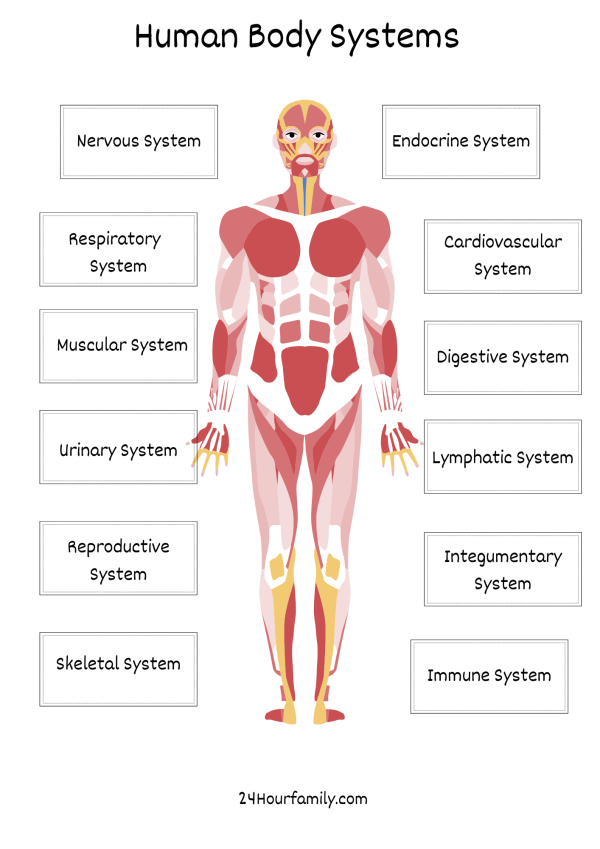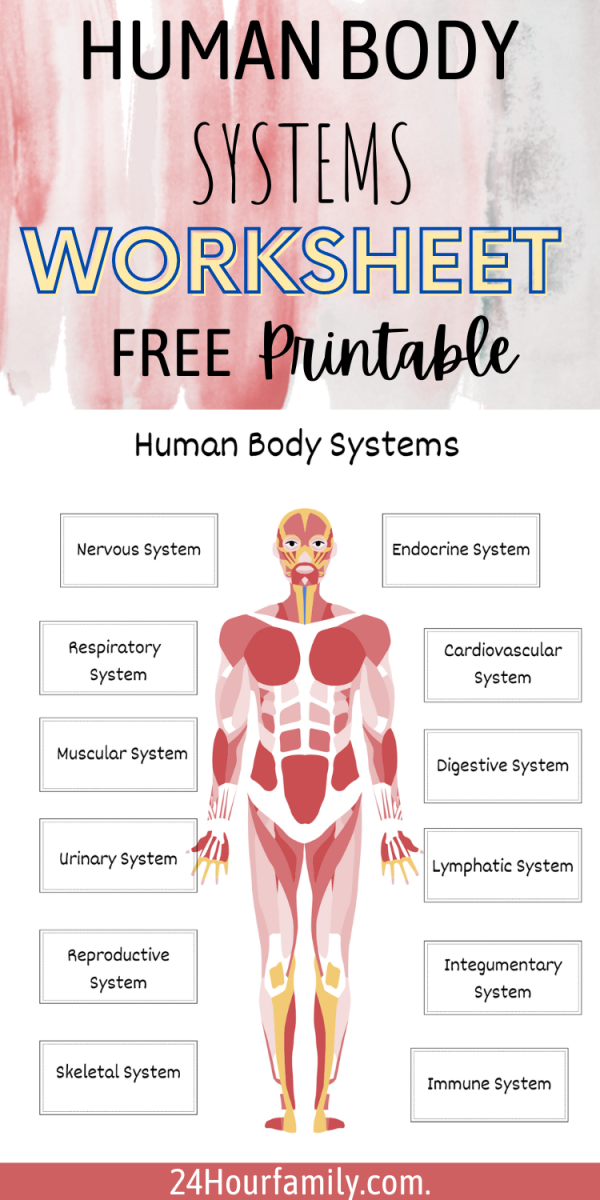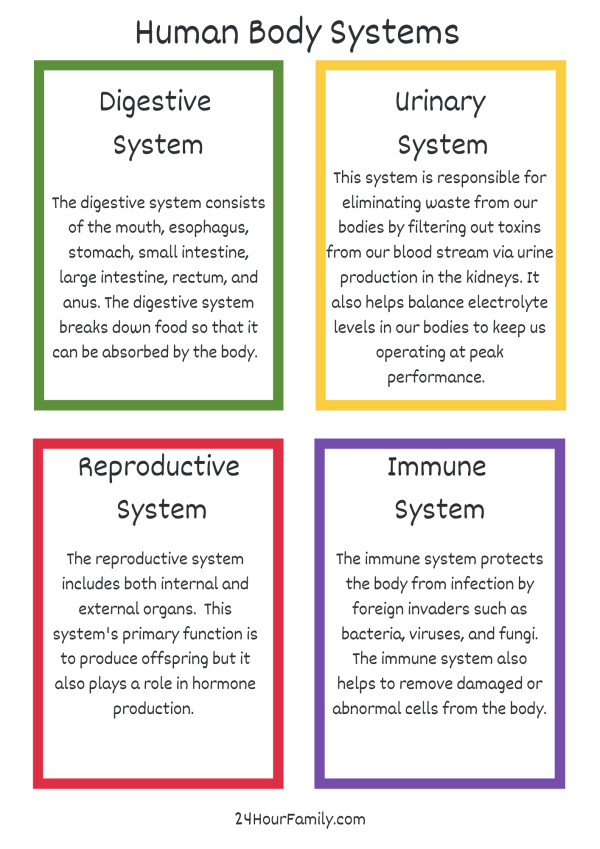Free Human Body Systems Worksheet
This free human body systems worksheet printable covers all of the different body systems. We have also included free printable human body systems flashcards that give details about each individual system. We also have more free educational printables here.
How many organ systems make up the human body? We have 12 organ systems – the skeletal system, the muscular system, the circulatory system, the respiratory system, the digestive system, the urinary system, the reproductive system, the nervous system, the endocrine system, the integumentary system, the lymphatic system, and the immune system.

This post contains affiliate links meaning I get commissions for purchases made through links in this post at no cost to you. Read my disclosure policy here.
Table of Contents
Human Body Systems Worksheet
Each one of these systems has a specific job to do and they all work together to keep us alive and healthy. Can you imagine what would happen if just one of these systems stopped working? It’s pretty amazing when you think about it.
To help kids learn about all of these different systems, we’ve created a free human body systems worksheet. This worksheet covers all 12 systems and provides some basic information about each one. kids will also have a chance to label a diagram of the human body. This is a great activity for kids who are interested in science.

The Major Body Systems:
The Skeletal System
The skeletal system is made up of bones and joints. It helps us move, gives our bodies shape, and protects our organs from injury. The bones in our skeletal system are held together by ligaments, which are tough bands of connective tissue. There are 206 bones in the adult human body. babies have even more bones because they have some bones that fuse together as they grow older. Did you know that your skeleton makes up about 20% of your body weight?
Fun fact: The longest bone in your body is actually in your leg. It’s called the femur and it’s about a foot long. The smallest bone is in your ear and it’s called the stapes. It’s only about 3mm long.
The Muscular System
The muscular system is responsible for helping us move. Our muscles are attached to our bones by tendons and they use energy from our food to contract and relax. There are three types of muscle tissue: skeletal muscle, smooth muscle, and cardiac muscle.
Skeletal muscle makes up 40% of our body weight and it’s what we use to walk, run, pick things up, etc. Smooth muscle is found in our internal organs (like our stomach) and it helps those organs contract or expand. Cardiac muscle is only found in our heart and it helps pump blood throughout our bodies.

The Cardiovascular System
The cardiovascular system is made up of the heart, blood vessels, and blood. Its primary function is to transport oxygen and nutrients to cells and remove waste products from cells. This system transports red blood cells throughout our bodies using arteries, veins, and capillaries.
Arteries carry oxygen-rich blood away from our hearts while veins carry oxygen-poor blood back to our hearts. Capillaries are tiny blood vessels that connect arteries and veins and they help exchange oxygen and carbon dioxide between our blood and tissues.
This Label the Human Heart Printable is perfect for grades 3rd – 10th to learn more about the anatomy of the human heart.
The Respiratory System
The respiratory system is made up of these four body parts – the lungs, trachea, bronchi, and diaphragm. Its primary function is to take in oxygen and get rid of carbon dioxide.

The Digestive System
The digestive system is a complex network of organs and tissues that work together to break down food and absorb its nutrients. From the moment we take our first bite, our digestive systems go to work breaking down food into smaller pieces so that it can be absorbed by our bodies.
The digestive system is made up of several organs starting with the mouth, into the esophagus then the stomach. The stomach continues to break down food then the food travels to the large intestine and small intestine.
The Urinary System
The urinary system helps rid our bodies of waste products like urine. To explain this concept to kids without going into overly complex details, you can compare our bodies to cars – just like cars need fuel to run properly and get rid of exhaust fumes when they are running too hot or too cold on the inside; our bodies also need fuel (food) but we get rid of waste products like urine instead of exhaust fumes so that our “engine” runs properly. This makes it much easier for kids to understand why they need the urinary system – without getting too technical or overwhelming them with information.

The Reproductive System
The reproductive system plays a very important role in life – creating new life! Though understanding this concept may be difficult for younger children, there are ways you can carefully explain it so that they can begin to comprehend it. For example, you could talk about how a seed needs soil and water in order for something like a flower or tree to grow. By using age-appropriate analogies, children can have a small, basic knowledge of the reproductive system.

Free Printable Human Body Systems Worksheet
The Nervous System
The nervous system is made up of the brain, spinal cord, and nerves. Its primary functions are to receive and process information, create thoughts and emotions, control body movement, and regulate organ function.
The Endocrine System
The endocrine system is a complex network that runs throughout our body. It is made up of hormones and glands, which work together to keep our bodies running like well-oiled machines. Hormones are chemicals that carry messages from one part of your body to another. Glands are organs that produce and release these hormones into the bloodstream.
The Integumentary System
The integumentary system is responsible for protecting us from outside germs and other external threats. It includes your skin, nails, hair, sweat glands, sebaceous glands (which produce oil), and even your teeth! To help kids understand this system better, you can use a simple analogy—like comparing their skin to an armor suit—to explain what it does. This will help them appreciate how important it is to take care of their bodies by keeping themselves clean and healthy.

The Lymphatic System
The lymphatic system is made up of lymph nodes, lymph vessels, spleen, thymus gland, tonsils, and bone marrow. Its primary function is to transport lymph fluid (which contains white blood cells) throughout the body and help fight infection.
The Immune System
The immune system protects the body from infection by foreign invaders such as bacteria, viruses, and fungi. The immune system also helps to remove damaged or abnormal cells from the body.
The human body is an amazing machine made up of 13 different systems that all work together to keep us alive. To help kids learn more about how these systems work together, we’ve created free human body systems worksheets that covers all 12 systems with some basic information about each one plus a chance to label a diagram of the human body. These human body worksheets will be helpful for a homeschool mom or for classroom use.
